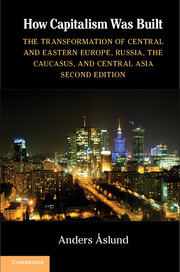 How Capitalism Was Built
How Capitalism Was Built Book contents
- Frontmatter
- Contents
- List of Tables and Figures
- Acknowledgments
- List of Abbreviations
- Introduction
- 1 Communism and Its Demise
- 2 Radical Reform versus Gradualism
- 3 Output
- 4 Liberalization
- 5 From Hyperinflation to Financial Stability
- 6 Privatization
- 7 The Social System
- 8 The Politics of Transition
- 9 From Crime Toward Law
- 10 The Importance of the European Union
- 11 The Global Financial Crisis, 2007–2012
- 12 Conclusions
- Bibliography
- Index
10 - The Importance of the European Union
Published online by Cambridge University Press: 05 December 2012
- Frontmatter
- Contents
- List of Tables and Figures
- Acknowledgments
- List of Abbreviations
- Introduction
- 1 Communism and Its Demise
- 2 Radical Reform versus Gradualism
- 3 Output
- 4 Liberalization
- 5 From Hyperinflation to Financial Stability
- 6 Privatization
- 7 The Social System
- 8 The Politics of Transition
- 9 From Crime Toward Law
- 10 The Importance of the European Union
- 11 The Global Financial Crisis, 2007–2012
- 12 Conclusions
- Bibliography
- Index
Summary
The collapse of communism and the Soviet bloc dominated public discussion all over the world in 1989. Many questions were raised: What relation would the postcommunist countries have to the West? What assistance did they need? What could and should the West do for them? Which organizations should be used? How much financing was needed, and was the West ready?
The West’s desire for the postcommunist countries’ success as democracies and market economies is often taken for granted, but western opinion was divided. Many favored democracy and market economies, even though most protagonists were doubtful about the prospects for democracy in the former Soviet Union. The West saw little threat from the former Soviet Union but also little gain. An important countercurrent argued that Russia was a patent menace best kept down and out. There was no consensus about what the West could or should do. In effect, the West as a whole adopted Central Europe, and Scandinavia adopted the Baltics. Southeastern Europe was left in a limbo, whereas Russia with the rest of the former Soviet Union was left out in the cold.
The qualitative contrast between Central and Eastern Europe and the former Soviet Union has widened in recent years. These rising discrepancies depend on the different choices of political regime and economic system, but these choices were preconditioned on the very different attitudes of the outside world toward these two groups of countries. History and culture were not as decisive as many believe, whereas they did influence western policy toward the region.
- Type
- Chapter
- Information
- How Capitalism Was BuiltThe Transformation of Central and Eastern Europe, Russia, the Caucasus, and Central Asia, pp. 301 - 325Publisher: Cambridge University PressPrint publication year: 2012


